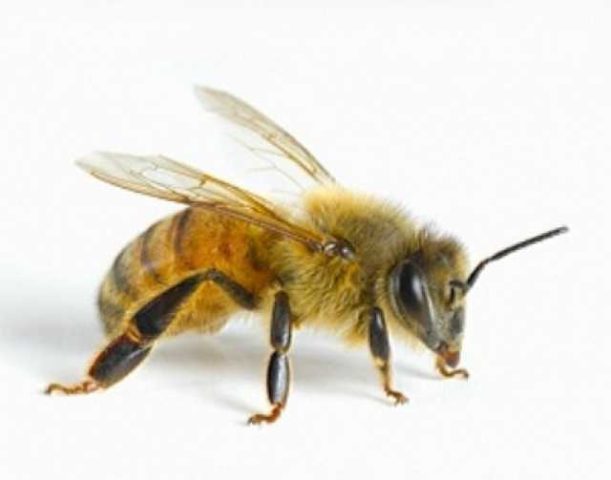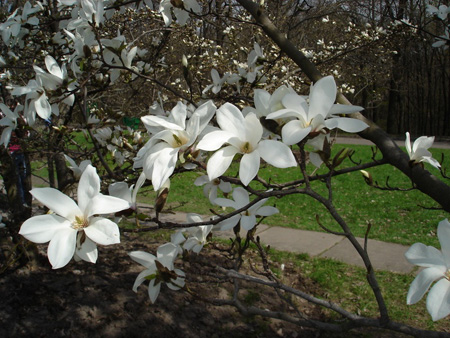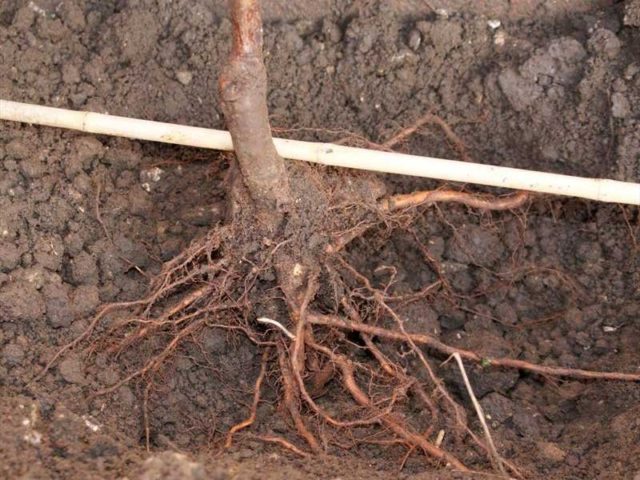Content
The garden becomes very festive when magnolia Kobus from the rhododendron family takes up residence in it. The area is saturated with a tropical atmosphere and pleasant aroma. The tree or shrub is covered with large flowers and intense green foliage. Some types of magnolia are winter-hardy crops that can withstand frosts down to -30 0C.
Description of magnolia Kobus
In 1794, Thunberg first studied the Kobus magnolia, a description and photo of which are presented below. In 1817, the culture finally received its current name. A deciduous tree in the wild can grow up to 25 m in height, and in a cultivated form - up to 10 m.
In the very first years, Kobus magnolia has a narrow pyramidal shape, and over time it becomes round or oval. The crown of the tree is flattened, reaching 6 m in diameter. In northern latitudes, the crop develops in the form of a wide bush. The trunk is dark gray in color with small cracks; over time it acquires brownish shades.
Deciduous buds have a small silky edge with fibers.The leaf blade is ovoid in shape with a sharp apex. It is wedged towards the base. Leaf length 8-13 cm.
How magnolia Kobus blooms
Magnolia Kobus flowers are milky white in color with a pleasant aroma. They are 10 cm in diameter. Each of them has three small sepals and six petals. When opened, the flowers show purple veins and many stamens. The gynoecium contains many carpels.
Magnolia Kobus blooms in the Moscow region in mid-spring, before the foliage has fully blossomed, and flowering lasts about two weeks. Usually this is the end of April.
Interestingly, magnolia flowers are sensitive to the pollination process when they are in bud form. When opened, they already lose this ability. Currently, Kobus magnolia is pollinated by small bugs, which carry pollen with their paws to still closed buds, and not by bees and other insects. Beetles are attracted to the pleasant smell of flowers.
Reproduction methods
The culture is characterized by natural renewal in the form of self-seeding. Also, the lower young shoots of shrubs can self-root. Magnolia Kobus can successfully reproduce by seeds. After collection, they are immediately sown in the ground so that they undergo natural stratification.
Propagation by cuttings shows that they are difficult to root. Most of the crops have an average degree of winter hardiness.
The best option for propagating Kobus magnolia is grafting cuttings. The plant gives good growth, begins to bear fruit early, and has increased endurance. Although, this method cannot be called easy. Vaccinations are done in the spring using a side incision or the application method.
Planting and caring for magnolia Kobus
The tree feels more comfortable in regions where a warm and humid climate prevails.When placing the Kobus magnolia in the garden, you need to think in advance about a place with comfortable conditions for it. It can be adversely affected by north and east winds.
It is advisable that there are no drafts where the Kobus magnolia grows. In the Moscow region, planting and care are the same as in other nearby regions. Choose a sunny place for planting Kobus magnolia. Shady areas should be avoided.
Recommended timing
The most favorable time for planting in open ground is autumn. Magnolia Kobus has good survival rate at the end of October, since at this time the culture is at rest. In spring, the tree can be planted in early April.
It is worth focusing on weather conditions to avoid frosts, otherwise they will cause irreparable harm to the crop. After all, after planting, the plant has not yet had time to fully strengthen.
Site selection and soil preparation
When choosing a place for Kobus magnolia, you need to take into account that the tree has a well-developed root system. The diameter of the hole is equal to three times the volume of the seedling root. It is noteworthy that young roots with a fine structure can be easily damaged. Therefore, special care must be taken when planting.
There is no need to be zealous with compacting the earth around the tree trunk circle. To prevent moisture from quickly evaporating, the top of the hole filled with soil is sprinkled with planed bark of coniferous trees.
Before planting Kobus magnolia, you need to study the composition and acidity of the soil. For normal development of the crop, slightly acidic soil enriched with organic and mineral fertilizer is suitable.
The composition should include turf soil - 2 parts, peat layer - 1 part, rotted compost - 1 part. We must not forget about drainage.If the soil is dense, then it is loosened with some coarse sand.
How to plant correctly
If the seedling initially grew in a container, then when transplanting into open ground, care is required so that the Kobus magnolia is not damaged. The crop's winter hardiness is average, so additional shelter will be required for the winter. If the root system is poorly covered, this can lead to the death of the plant.
For planting, the hole is prepared in advance, the earthball is carefully removed from the container and placed in the center. It is advisable to fill the hole with a good soil mixture, which is prepared when planting the seed.
Dimensions of the hole for a half-meter magnolia seedling: depth - 50 cm, width - 80 cm. As the seedling develops, there is no need to replant it repeatedly, this will delay the onset of flowering. It is better to devote due time to choosing a permanent place for the culture. We should not forget about watering, fertilizing, and mulching.
Growing rules
In order for a culture to develop well, it must be properly cared for. Although there are no special differences from other types of fruit trees. Magnolia Kobus has a root system located near the surface of the earth, so you need to loosen the soil carefully. The permissible depth is up to 10-15 cm.
When the magnolia reaches three years of age, it is recommended to apply mulching material under the tree trunk. Rotted manure mixed with hay, sawdust, planed pine bark, and peat are suitable. On the one hand, mulch is an insulator, and on the other, it is a source of nutrients.
Watering
Young seedlings of the Kobus magnolia especially need good watering, and adult plantings especially need it in dry, hot summers. For normal development of the crop, it needs to be watered once a week.
One tree requires 2-3 buckets of water when watering. If the soil is sandy, then the number and abundance of watering can be slightly increased. Mulching is used to retain moisture in the soil for a long time.
Top dressing
After planting in the third year, Kobus magnolia begins to be fed with fertilizers and nutritional complexes.
- In early spring, you can add the following composition to the soil: liquid mixture of mullein - 1 kg, urea in crystals - 15 g, ammonium nitrate - 25 g.
- In autumn, the crop is fertilized with the following composition: nitroammophoska powder - 20 g - is added to 10 liters of water.
- One tree requires 40 liters of liquid when watering.
As a fertilizer, ready-made fertilizer "Kemir Universal" has proven itself well. For 10 liters of water you need to dilute 1 tbsp. l. liquid solution. You can also use specialized formulations intended for magnolias. In case of overdose, the foliage may dry out.
Trimming
It should be noted that magnolia Kobus has a negative attitude towards pruning. Therefore, this process should be resorted to in extremely rare cases. For example, pruning is allowed in 1-2 years of crop development to give shape and decorativeness to the seedling.
Only sanitary pruning of old and damaged branches is recommended. You can thin out the crown if it is very thick. The cuts need to be treated with garden varnish.
Preparing for winter
Many types of mature Kobus magnolia trees are able to withstand frosts down to -25-30 0C in winter cold. But young bushes need to be taken care of at first. During the first three years, the tree trunk needs to be covered for the winter to protect the root system from the cold.
As insulation, you can use special agrotechnical material - lutrasil, burlap, chopped straw, sawdust, peat or spruce branches. As the crop ages, its winter hardiness increases.
Pests and diseases
Unlike many garden crops, Kobus magnolia is rarely affected by diseases. But some species can still overshadow the joy of gardeners who are passionate about growing this beautiful and fragrant planting. For example:
- The appearance of yellowish spots on the foliage indicates chlorosis. Excessive lime in the soil can lead to the death of the root system.
- An alkaline environment is also harmful to the roots of Magnolia Kobus. The tree may dry out.
To correct the situation, you need to add an acidified peat layer, soil from the tree trunks of coniferous trees and other special means to the soil. They will help regulate acidity.
Thrips, peach aphids, and mealybugs can cause damage to exotic crops. During the hot season, the tree can be attacked by spider mites and other types of mites. They feed on the juice of the leaf blade.
Conclusion
Magnolia Kobus is an exotic tree or shrub distinguished by the aroma and beauty of its flowers. It is better to plant it next to other types of fruit crops. In this case, you will be able to fully experience paradise in your garden. With the joint planting of fern bushes, the ginkgo corner will take on an archaic look, where you can enjoy the blooming “white bows”.

















